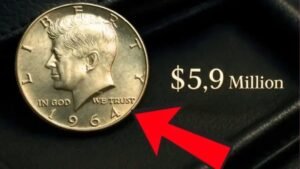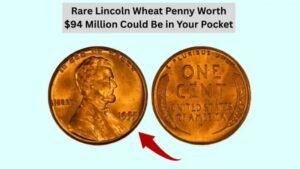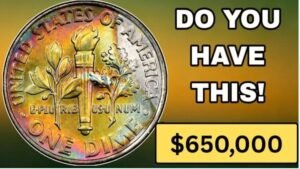Picture finding a penny in your pocket change worth over $450,000! The Lincoln Wheat Penny, a common coin minted from 1909 to 1958, has some rare versions that collectors pay huge sums for, with one fetching $456,000 at auction. Known for its iconic Abraham Lincoln portrait and wheat stalk design, this penny could still be hiding in your wallet, coin jar, or cash register.
A famous example is the 1955 Double Die Lincoln Penny, prized for a striking minting error. In this article, we’ll explain in simple English what makes these pennies so valuable, how to spot them, and why they excite coin collectors. We’ve also included a table with complex terms explained in easy English to help everyone understand. Optimized for SEO, this guide is perfect for anyone eager to discover a valuable coin in their spare change.
What is the Lincoln Wheat Penny?
The Lincoln Wheat Penny, often called the “Wheatie” by collectors, was first minted in 1909 to celebrate the 100th anniversary of Abraham Lincoln’s birth. Designed by Victor David Brenner, it was the first U.S. coin to feature a president’s portrait. The front, or obverse, shows Lincoln’s profile, while the back, or reverse, has two wheat stalks framing the words “ONE CENT” and “UNITED STATES OF AMERICA.” Minted until 1958, when it was replaced by the Lincoln Memorial design, these pennies were made of 95% copper except in 1943, when most were zinc-coated steel due to wartime copper shortages.
Certain Lincoln Wheat Pennies are worth far more than their one-cent face value due to rare errors or low mintage. The 1955 Double Die Obverse (DDO) penny, with its noticeable doubled date and lettering, is a collector’s favorite, with one selling for $456,000. Other valuable versions include the 1943 Bronze Penny, accidentally struck in copper, and the 1909-S VDB, with low production numbers. These rare coins could still be in circulation, making them a thrilling find for collectors.
Key Features of the Valuable Lincoln Wheat Penny
Here’s a quick look at what makes these rare pennies special:
| Feature | Description |
|---|---|
| Obverse Design | Abraham Lincoln’s portrait, designed by Victor David Brenner. |
| Reverse Design | Two wheat stalks around “ONE CENT” and “UNITED STATES OF AMERICA.” |
| 1955 Double Die Error | Blurry, doubled date and “LIBERTY” on the front due to a misaligned minting die. |
| 1943 Bronze Error | Copper penny mistakenly minted in 1943 instead of steel; only 10–15 exist. |
| Material | 95% copper (except 1943 steel pennies); bronze errors are reddish-brown. |
| Rarity | Fewer than 20,000 1955 DDO pennies; fewer than 15 1943 bronze pennies exist. |
| Value | Up to $456,000 for 1955 DDO or $2.7 million for 1943 bronze in top condition. |
Why is the Lincoln Wheat Penny So Valuable?
The 1955 Double Die Error
The 1955 Double Die Obverse (DDO) penny is one of the most sought-after Lincoln Wheat Pennies due to a minting error at the Philadelphia Mint. During production, the die (a metal stamp used to make coins) was misaligned, causing the date “1955” and the word “LIBERTY” to appear doubled or blurry. This error is visible to the naked eye, making it easier to spot than other subtle errors. Only about 20,000–24,000 of these coins were released, and their rarity drives their value. A 1955 DDO penny in near-perfect condition (graded MS65 or higher) sold for $456,000, though even circulated ones can fetch $1,000–$33,000 depending on condition.
The 1943 Bronze Error
Another ultra-valuable Lincoln Wheat Penny is the 1943 Bronze Penny. In 1943, during World War II, the U.S. Mint switched to zinc-coated steel for pennies to save copper for the war effort. However, a few leftover copper blanks from 1942 were accidentally used, creating a handful of bronze pennies. Only 10–15 are known to exist, and one sold for $2.7 million in recent years. These coins are reddish-brown, unlike the silver-colored steel pennies, and don’t stick to a magnet, making them easy to identify. Their extreme rarity and historical significance make them a collector’s holy grail.
Rarity and Condition
The value of a Lincoln Wheat Penny depends on its rarity and condition. Coins with errors like the 1955 DDO or 1943 bronze are scarce, with only a small number escaping the mint’s quality checks. The condition, or grade, also matters—coins graded MS65 or higher (Mint State, meaning uncirculated) by services like PCGS or NGC fetch the highest prices. For example, a pristine 1955 DDO penny is worth hundreds of thousands, while a worn one might still sell for thousands. The 1943 bronze penny’s value can soar to millions in top condition due to its scarcity.
Historical Significance
The Lincoln Wheat Penny holds a special place in American history as the first coin to feature a real person, Abraham Lincoln, the 16th U.S. President. Introduced in 1909, it marked Lincoln’s centennial and became a symbol of national pride. The wheat stalk design reflects America’s agricultural heritage, adding nostalgic appeal. Rare errors like the 1955 DDO or 1943 bronze tie into significant eras, like post-war recovery or World War II, making them not just coins but pieces of history that collectors cherish.
How to Spot a Valuable Lincoln Wheat Penny
Finding a $450,000+ Lincoln Wheat Penny is possible with careful inspection. Here’s how to check your coins:
- Look for the 1955 Double Die: Check 1955 pennies with no mint mark (from Philadelphia). Use a magnifying glass to spot doubling on the date “1955” and “LIBERTY.” The doubling looks blurry or has distinct double lines.
- Check for 1943 Bronze: Look for 1943 pennies that are reddish-brown, not silver. Test with a magnet—steel pennies stick, but bronze ones don’t. Weigh the coin: bronze pennies are 3.11 grams; steel ones are 2.7 grams.
- Inspect Other Key Dates: Watch for rare dates like 1909-S VDB (with designer’s initials on the reverse), 1914-D, or 1922 No D (missing mint mark). These can be worth $5,000–$100,000.
- Examine Condition: Look for shiny, uncirculated coins with sharp details and no scratches or wear for the highest value.
- Compare with Images: Search online for “1955 Double Die Penny” or “1943 Bronze Penny” images to match the error.
If you find a potential rare coin, preserve its value with these steps:
- Don’t Clean It: Cleaning can scratch the surface and lower its worth.
- Handle Carefully: Use cotton gloves or hold by the edges to avoid fingerprints.
- Get It Graded: Send it to PCGS or NGC for professional grading and authentication.
- Consult Experts: Visit a reputable coin dealer or auction house like Heritage Auctions for an appraisal.
Simple English Explanations for Complex Terms
To make coin collecting easier, here’s a table explaining tricky terms in simple English:
| English Term | Simple English Explanation |
|---|---|
| Numismatics | The hobby of collecting and studying coins and paper money. |
| Double Die | A minting error where the design (like date or words) appears doubled. |
| Minting Error | A mistake made when making a coin, like using the wrong metal or die. |
| Obverse | The front side of a coin, usually with a portrait or main design. |
| Reverse | The back side of a coin, often with a secondary design like wheat. |
| Mint Mark | A small letter (like “S” or “D”) showing where the coin was made. |
| Grading | Checking a coin’s condition and giving it a quality score (e.g., MS65). |
Comparison with Other Valuable Lincoln Wheat Pennies
The 1955 DDO and 1943 Bronze Pennies aren’t the only valuable Wheat Pennies. Here’s how they compare to other rare variants:
- 1909-S VDB: Only 484,000 made, with designer Victor David Brenner’s initials on the reverse. Worth up to $100,000 in high grades.
- 1914-D: A rare Denver issue with only 1.2 million minted. High-grade versions sell for $5,000–$159,000.
- 1922 No D: Missing the Denver mint mark due to a die error. Valued at $1,000–$10,000 depending on condition.
- 1944-S Steel Penny: A rare steel penny from 1944, when copper was used again. Only two exist, valued at $1.1 million.
The 1955 DDO’s $456,000 value is high, but the 1943 Bronze Penny can reach $2.7 million due to its extreme rarity. The 1955 DDO is more likely to be found in circulation, making it a realistic target for collectors.
Why Collectors Love Lincoln Wheat Pennies
Lincoln Wheat Pennies are a cornerstone of coin collecting due to their historical significance, iconic design, and rare errors. The 1955 DDO’s dramatic doubling and the 1943 Bronze Penny’s wartime story make them stand out. Collectors are drawn to the thrill of finding a rare coin that slipped through the U.S. Mint’s quality checks, like a penny worth hundreds of thousands. Stories of people finding these coins in bank rolls, old jars, or pocket change keep the hunt alive. Social media buzz, like posts on X about million-dollar pennies, fuels excitement, though some claims (like a $47 million penny) are unverified and likely exaggerated.
Tips for Finding Valuable Lincoln Wheat Pennies
You don’t need to be an expert to find a valuable Wheat Penny. Here are practical tips to start your search:
- Check Pocket Change: Look at pennies from cash registers, vending machines, or your wallet, especially those dated 1909–1958.
- Buy Bank Rolls: Purchase rolls of pennies from banks, particularly pre-1980 rolls, to inspect for errors.
- Search Old Collections: Check inherited coin jars, piggy banks, or family safes for Wheat Pennies.
- Visit Coin Shows: Attend local coin shows or flea markets to find rare coins from dealers or collectors.
- Use Online Resources: Check eBay, USA Coin Book, or forums like Reddit’s r/coins for images and tips on spotting errors.
Where to Sell a Valuable Lincoln Wheat Penny
If you find a rare Wheat Penny, here’s how to sell it for the best price:
- Get It Graded: Professional grading by PCGS or NGC confirms authenticity and boosts value.
- Visit Coin Dealers: Reputable dealers can appraise and offer a fair price or connect you with buyers.
- Use Auction Houses: Platforms like Heritage Auctions or Stack’s Bowers specialize in rare coins and attract high bids.
- Sell Online: List the coin on eBay or GreatCollections, but ensure it’s graded to avoid scams.
Conclusion
The Lincoln Wheat Penny, with its iconic design and rare errors like the 1955 Double Die or 1943 Bronze, proves that a simple penny can be worth over $450,000. These coins, still occasionally found in circulation, are treasures hiding in plain sight—in wallets, coin jars, or cash drawers. By checking for key dates, errors, and using a magnet test for 1943 pennies, you could uncover a life-changing find. The story of a $456,000 1955 DDO penny or a $2.7 million 1943 Bronze Penny shows the thrill of coin collecting. So, next time you get a penny in change, take a closer look—it might just be your ticket to a fortune.
FAQs
1. What makes the 1955 Lincoln Wheat Penny valuable?
The 1955 Double Die Obverse penny has a noticeable doubling error on the date and “LIBERTY,” making it rare. One sold for $456,000 due to its scarcity and condition.
2. How do I spot a 1955 Double Die Penny?
Look for a 1955 penny with no mint mark (Philadelphia). Check for blurry or doubled date and “LIBERTY” using a magnifying glass.
3. What is the 1943 Bronze Penny, and why is it valuable?
It’s a 1943 penny mistakenly made in copper instead of steel due to wartime shortages. Only 10–15 exist, with one worth $2.7 million.
4. How can I tell if a 1943 penny is bronze?
Check if a 1943 penny is reddish-brown and doesn’t stick to a magnet (steel pennies do). It should weigh 3.11 grams, not 2.7 grams.
5. Where can I find a valuable Lincoln Wheat Penny?
Look in pocket change, bank rolls, old coin jars, or at coin shows. Online platforms like eBay or Heritage Auctions also sell them.
6. What should I do if I find a rare Wheat Penny?
Don’t clean it. Store it in a protective sleeve, get it graded by PCGS or NGC, and consult a coin dealer or auction house for appraisal.
Sources: alleyscafe.com, oto-mobility.com, blueskyschools.org, coincollecting.com, USACoinBook




